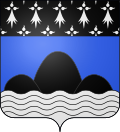Carantec
Carantec (French pronunciation: [kaʁɑ̃tɛk]; Breton: Karanteg) is a commune in the Finistère department of Brittany in north-western France. Carantec is located on the coast of the English Channel. It contains a small island within its boundaries, Île Callot, which can be reached by a causeway during most low tides (except at neap tide). Carantec is bordered by the communes of Henvic and Taulé to the south, and is near the town of Morlaix. International relationsCarantec is twinned with
Local industriesCarantec's two primary industries are oyster farming and tourism. TourismSince 1926, Carantec has been classified as a "station balnéaire".[3] Oyster farmingCarantec and the Bay of Morlaix have been home to oyster farming operations since 1892. Today Carantec is home to 15 oyster farms with over 700 hectares of oyster beds that produce over 6500 tonnes of oysters per year.[4] PopulationInhabitants of Carantec are called in French Carantécois.
Sights
See alsoReferences
External links
Wikimedia Commons has media related to Carantec.
|
||||||||||||||||||||||||||||||||||||||||||||||||||||||||||||||||||||||||||||||||||||||||||||||||||||||||||||||||||||||||||||||||||||||||||||||||||||||||||||||||||||||


















